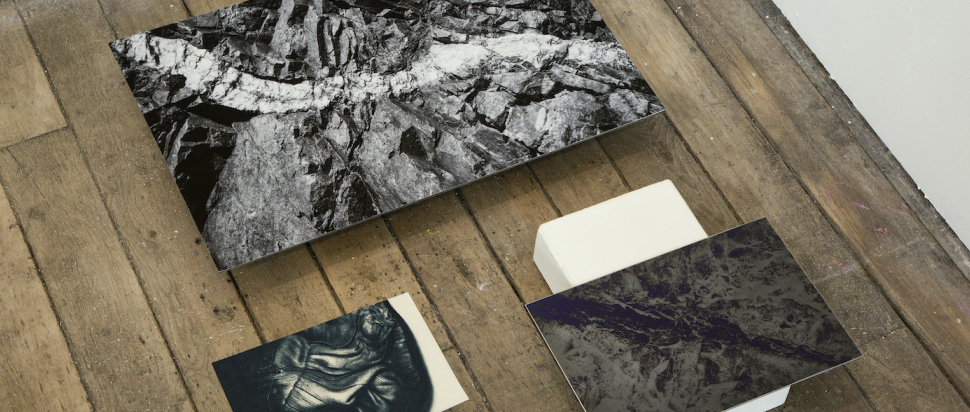Glasgow School of Art Degree Show 2022: The review
Glasgow School of Art's 2022 graduates pull together an optimistic and energetic show full of bold, experimental energy
2022's final year students faced unprecedented difficulties, spending almost two years away from the studio and their creative communities. Despite this, the show is a largely optimistic and energetic affair. It’s exciting to see students of all disciplines being bold in their choice of materials and broad in examining approaches to their practices. Distance from the studio has encouraged inventive experimentation in a range of mediums, with textiles emerging as a particularly generative area.
Anuschka Barlas’s beautifully rich tapestries make full use of the medium’s slow intensity. Using Shetland wool to weave intimate self-portraits and close-up abstract fragments of the Scottish countryside, Barlas’s textile work has the dreamlike quality of distant memories recalled through a haze of nostalgia. The self becomes a landscape, woven into and from its surroundings. Nuala Abramson turns to embroidery to create a sense of self and belonging. Working with golden thread and metallic beads, the pieces draw on Byzantine wall hangings with surprising flourishes: the flesh and bone of a rib cage, or a naked woman’s silhouette in a piece titled Petit Mort.
Anna Winther’s embroidered used napkins commemorate meals and family occasions. Decorative beaded sections mark the stains and spillages mopped up by each napkin over the course of a meal. Winther’s napkins tie craft’s labour-intensive, slow process to a reaction against the consumer culture that encourages us to throw away used items. The simple white squares evoke a sombre, ghostly atmosphere, which speaks of the many missed celebrations of the pandemic years.
Not all the textile works are intimate and introspective; in fact, several of the artists working with stitching and fabrics extend their practice outward to involve other makers. Meadhbh Corrigan’s Abolition Workshop Quilt is a powerful statement of solidarity with incarcerated people and their families, made with eight other students during reading and stitching workshop sessions. A collaborative act of care that counters the cruelties of the carceral system, Corrigan’s quilt was then sold to raise funds for Glasgow Prisoner Solidarity Collective.
Knitter Kitty Glover created many of their stitched creatures in collaboration with attendees of Platform’s weekly Clack and Yak group. The whimsical beasts are the product of social, intergenerational gatherings, where people exchange knowledge and skills in an informal, unacademic environment. Patchwork curtains frame Nancy Pilkington’s otherworldly installation, a childhood den made of ragged squares of pink fabric. Inside, a small sailing boat complete with a patchwork sail promises escape and adventure. Frayed seams and the tattered objects displayed inside cast this as a place of creative repair. Katie Hogg’s candy-coloured installation takes a brighter and bolder approach to spaces of fantasy, using contrasting textures and soft sculptures to encourage play.
Several Fine Art Photography students have also chosen to foreground the physical materiality of their medium. Louis Syed-Anderson gathers different-sized images printed on a variety of textures, arranging them across the room to form a landscape. Navigating the installation, the viewer gets up close to the detailed surfaces and materials Syed-Anderson captures as if encountering a geological structure. Spencer Dent’s Genderless combines costume, portraiture, and weaving to celebrate androgyny and nonbinary gender. Dent’s screen-printed self-portraits recall Dada Cabaret Voltaire performances and Leigh Bowery’s avant-garde costumes; their use of PVC adds a tactile edge which is emphasised further in a woven work, showing a ghoulish face stretched on an iron frame.
Emerging from a time marked by isolation and physical separation, it’s unsurprising that communication and its limits emerge as another recurring theme. Kathleen Lodge finds humour and comfort in everyday phrases, some of which are specific to her native East Midlands, printed in plain text. The mass-produced objects she chooses to brand – mugs, beer bottles, beermats, cushions – evoke homely, comforting spaces. Lodge commemorates and elevates the commonplace interactions that take place in the area into something more permanent.
Words become (quite literally) sharp and weighted in Tiago Rodrigues’ work, where flippant, sarcastic and nihilistic phrases become sculptural forms crafted from chains, barbed wire, and bricks. Rodrigues’ tapestry work strikes a more melancholic note: in one example, the stitched word ‘Saudade’ (from Portuguese, with no equivalent in English, referring to a deep sense of yearning) bulges from a canvas entitled Get Well Soon. Rodrigues’ mixture of hard defiance and nostalgic longing sets the tone for the show, in which an array of urgent, interesting voices emerge from the gloom, promising exciting things to come from Scotland’s new generation of artists.
Run ended; view more work by this year's GSA graduates at gsashowcase.net
